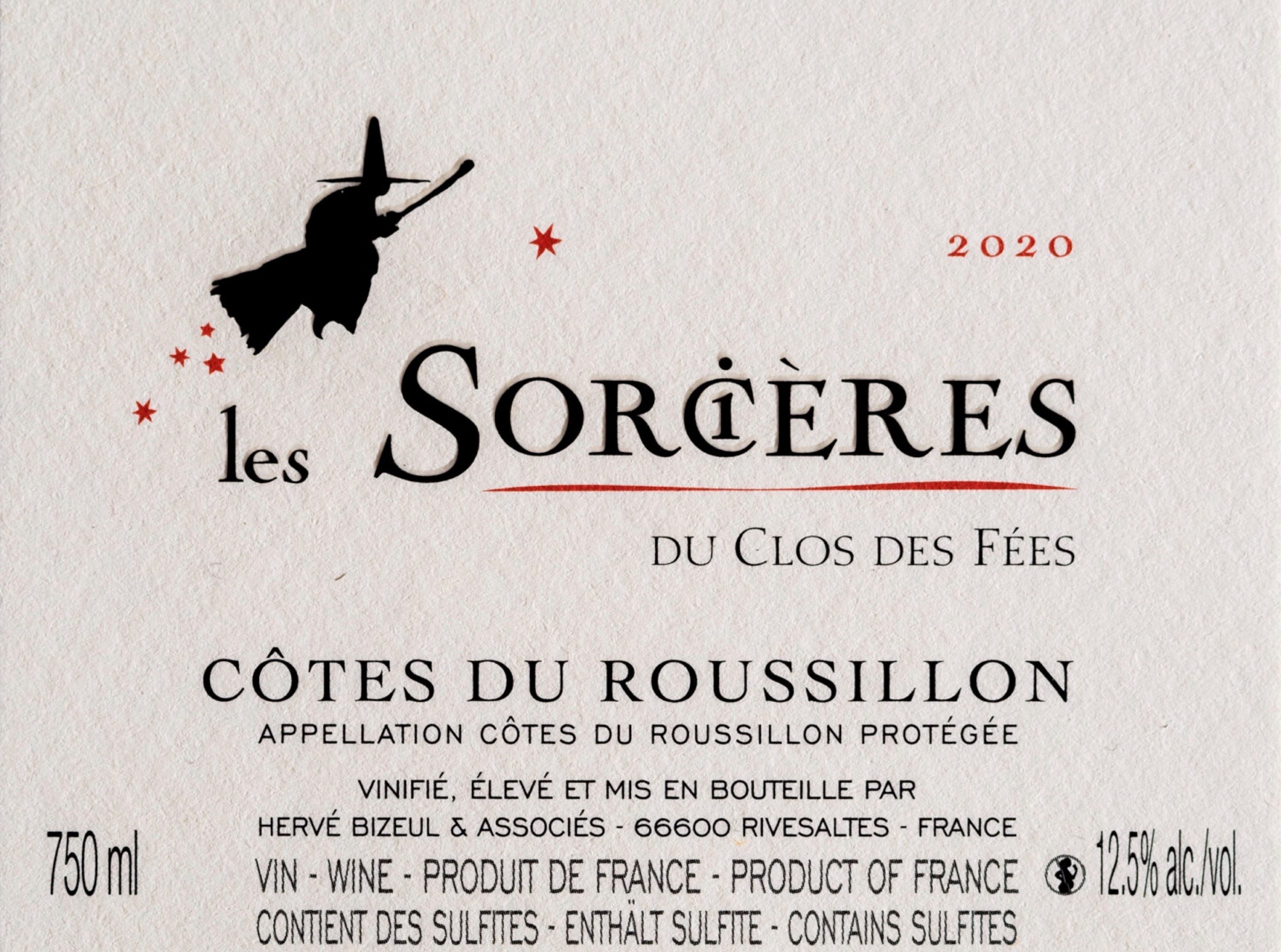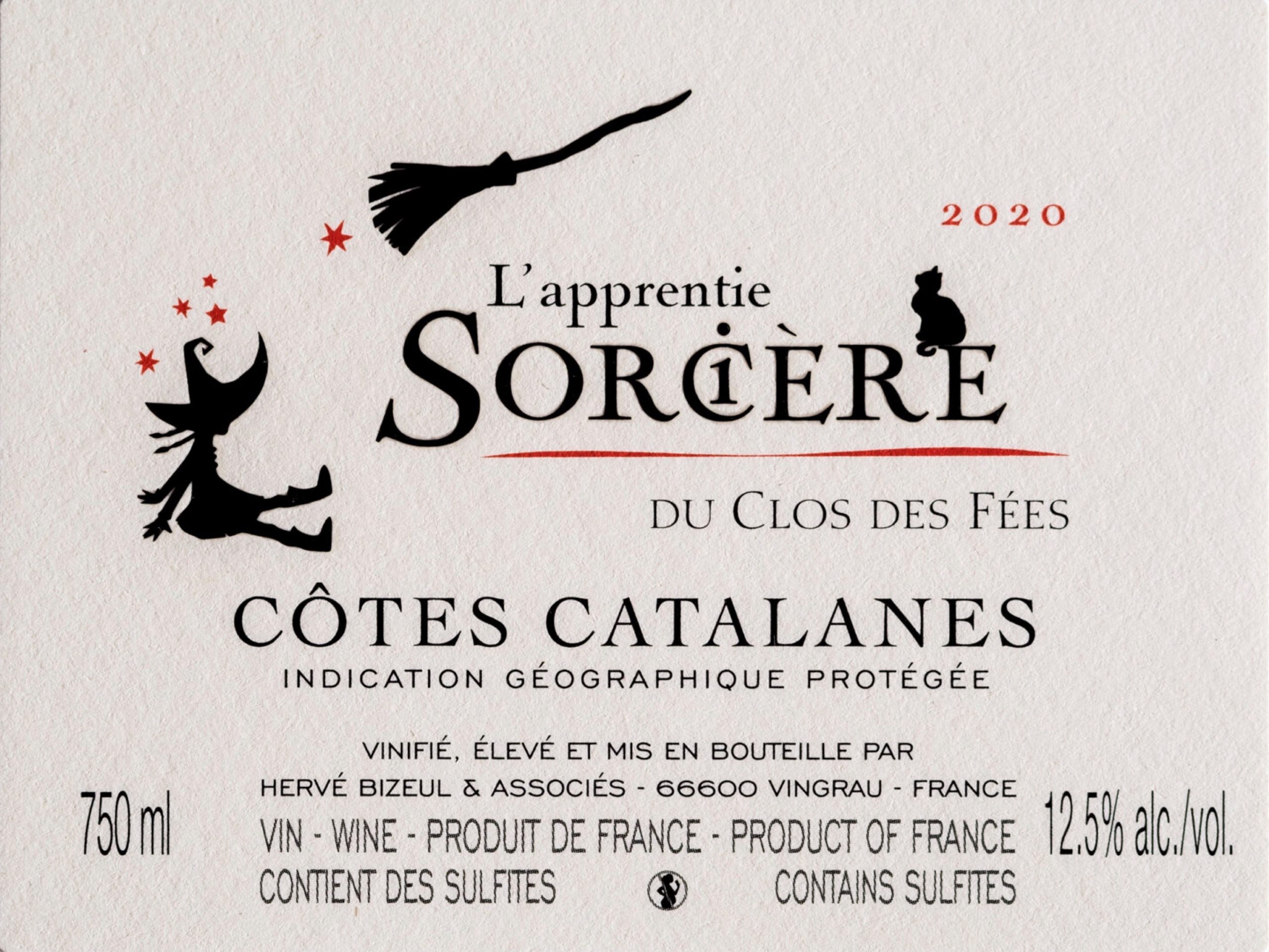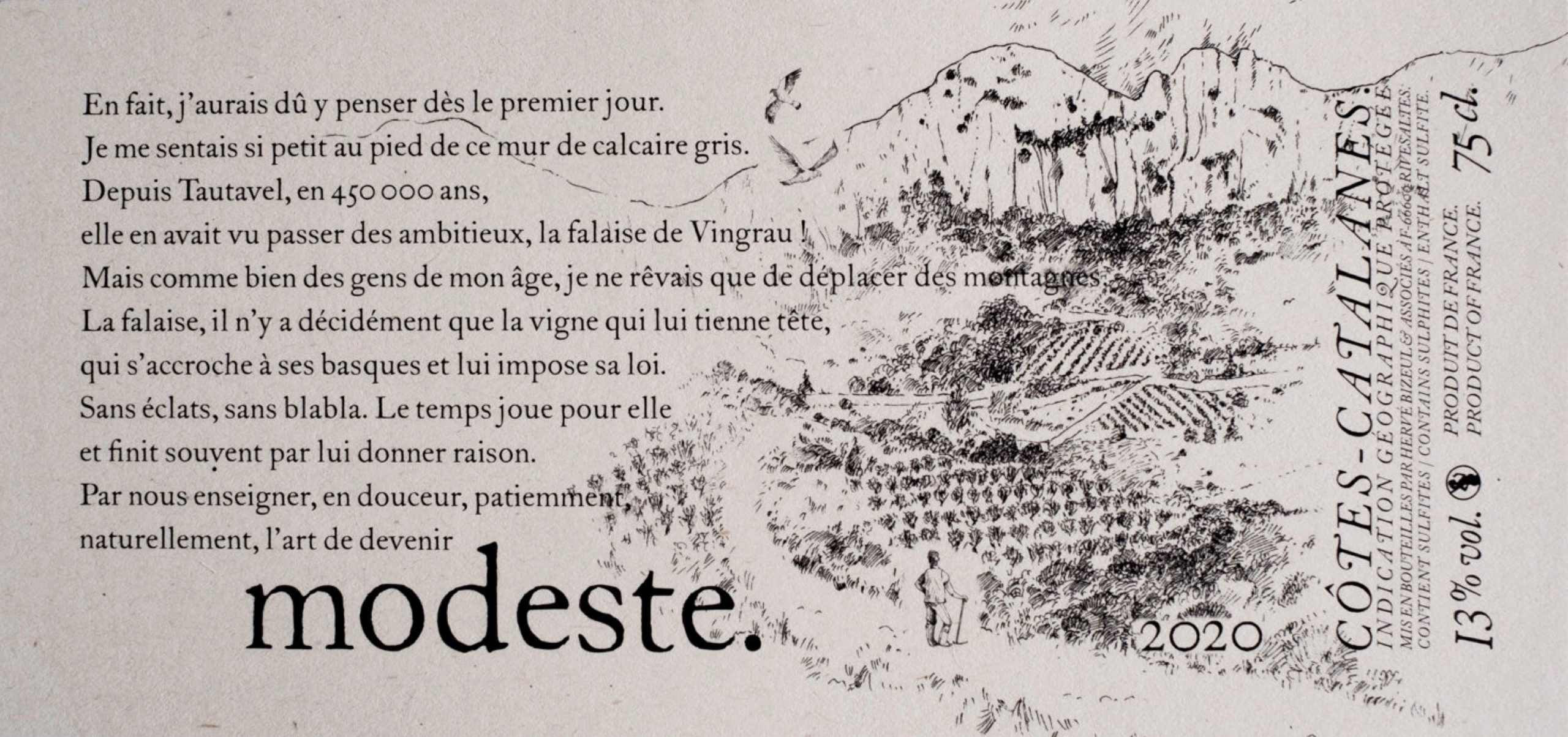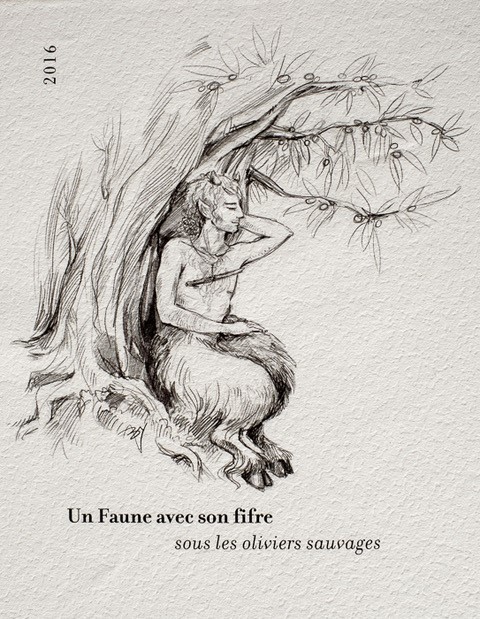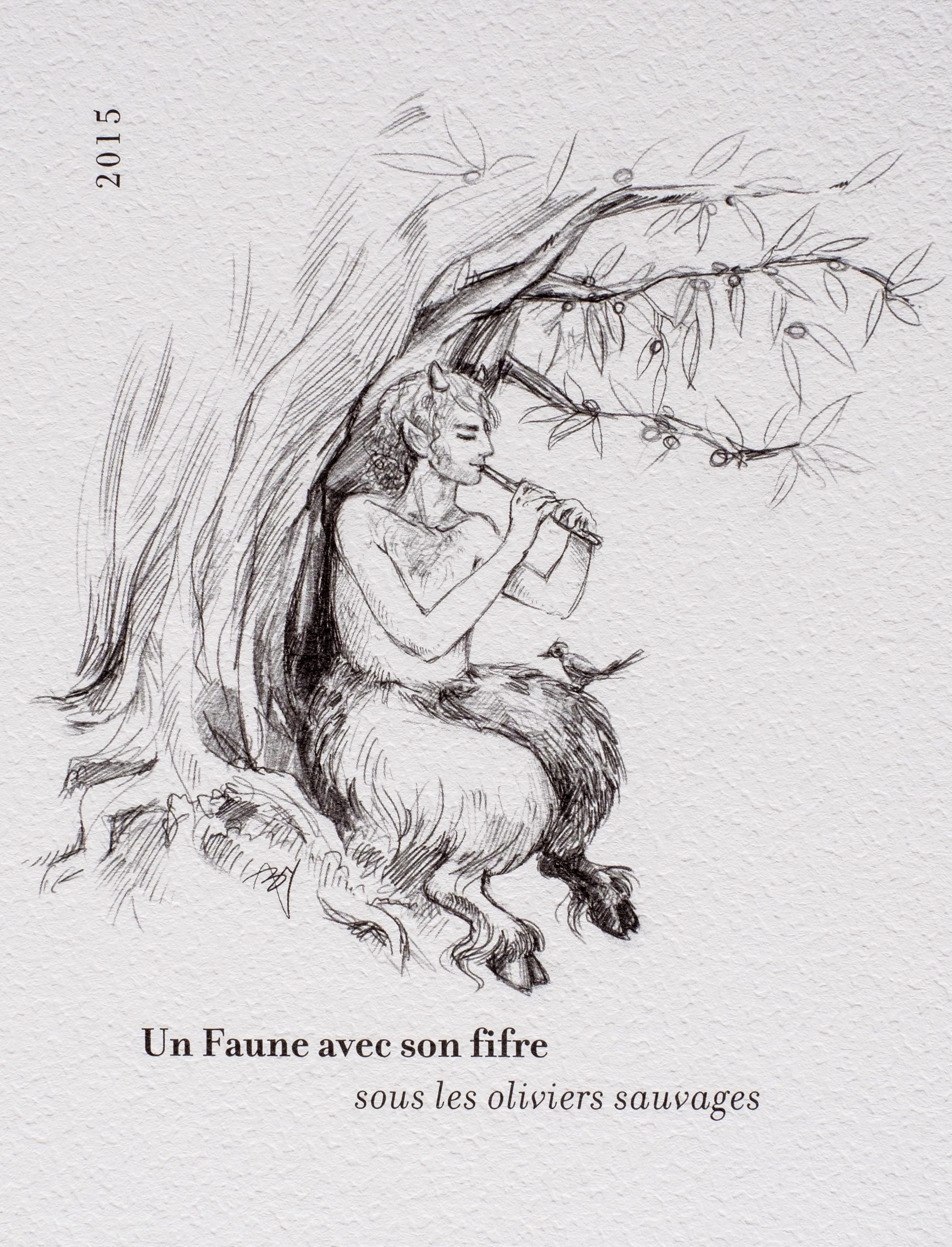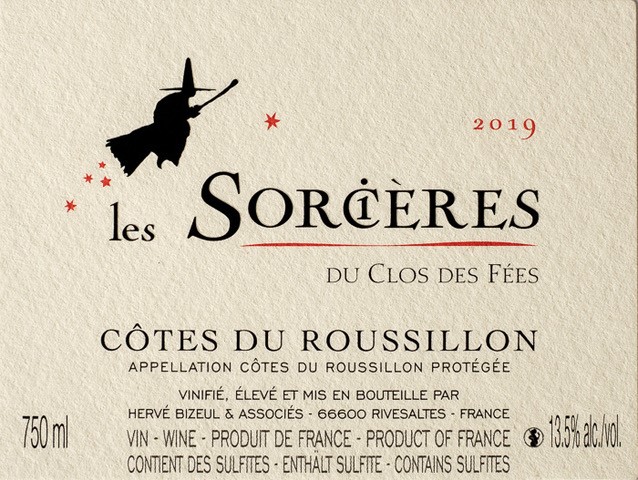

Syrah 50 %, Grenache 30 %, Carignan 20 %. The Grenache and Carignan are selected from old vines of between 40 and 80 years old and young vines of Syrah. Mainly limestone-clay soils. The date for the harvest is picked to obtain the best possible fruit while maintaining balanced acidity. The grapes are picked manually.
Pre-fermentary cold maceration is done in 128 hectolitres stainless steel tanks with daily pumping-over. Maceration, Temperature-controlled, lasts between 15 and 21 days, obtaining soft extraction. Full malolactic fermentation. Aged for 8 months in tanks on fine lees and minimal quantities of SO2 added during ageing and at bottling. The concentration of this medium-body wine has been voluntarily controlled for maximum drinkability: explosive fruit flavors, delicate tannins and a silky texture… Delicious right from the time it has been bottled; will improve over the next two to three years.
“Expressive nose of black fruit, the mouth explodes with fruit. Finesse and elegance complement this real pleasure wine”.
2010 vintage, Guide Bettane-Desseauve, 2012 15,5/20“The nose is full of ripe black fruits, slightly meaty with hints of mint. Fruity palate, fresh, with lovely aromatics. Perfect with a rabbit terrine”
2009 vintage, Pierre Casamayor, Guide Hubert 2011 3,5 glass out of 5“Well-defined fruit, refined structure”
Guide Gault et Millau 16/20“Dense, powerful, easy to drink. Its freshness will allow the bottle to be finished quickly during a meal. Aren’t these essential qualities for a good wine”
Thierry Desseauve“Crunchy fruit, a delicacy”
Guide de la Revue du Vin de France 16/20« There's concentrated blueberry and raspberry flavors in this full-bodied red. Cocoa powder notes, with hints of braised beef, provide focused accents, with licorice on the finish. Carignan, Grenache and Syrah. Drink now through 2014 »
2008 Vintage, Kim Marcus - Wine Spectator, september 10, 2010 89 points“A rich wine with good acidity, peppery, with fine tannins and a fresh finish, a good pairing with a fillet of lamb with herbs, Basque chicken”
Christian Flacelière, Le Figaro Magazine« Almost a meal in itself, it you want to sit with friends, sip it, talk about it and take another sip... »
Jacqueline Friedrich, The Herald Tribune“Silky texture, elegance and persistence complement exceptional fruit”
La Revue du Vin de FranceYoung grapes from Vermentino and Roussanne planted in 2011 in limestone-clay soils. Both multi-clonal planting and massal selection on a dense parcel plot- 7000ft/ha on 3309 rootstock. Old Maccabeo grapes (1945 plantation) located in ‘Lou Bac’, standard gauge per square which means 1,65 x 1,65.
Maximum ripeness is aimed for, as well as moderate alcohol content. Grapes hand-picked in the morning, and then transported in refrigerated trucks. Whole grapes directly pressed at a low heat and low pressure (5 hours) in order to preserve the fruit and stop oxidation. Light debourbage to enable the growth of lees necessary to the yeast’s autolysis. Low heat fermentation with natural yeasts in tanks. Maturation on fine lees, fining with clay, early bottling in February. A fruity, airy, tasty first impression on the palate, a taut wine but just what you need, ripe and crisp with a thirst-quenching and easy to digest finish, which makes you want to swig it down. An obvious choice for mediterranean-style cooking.
A blend of young black Grenache and old Carignan planted on layers of shales and mica-schist, in the Espira de l’Agly village. Syrah planted in the clay-limestone soil of Vingrau, a seven-year old vine planted on 6800ft/hectare by the domaine. Mourvèdre in Opoul, from the ‘Mas Farines’ terroir, a fifteen-year old grape.
Early harvest for the Grenache in order to obtain maximum ripeness and low alcohol content. Grapes picked in the morning and transported in skips with vibrating spouts. Direct pressing at low heat and low pressure (4 hours) for minimal colouring of the must. The Syrah grapes harvest was delayed by one and a half week and the Mourvèdre started the third week of September. A fast but light debourbage in order to keep nutrients and character. Long fermentation on fine lees with stirring to avoid reduction and an early bottling.
A clear and bright wine with notes of berry, lychee and grapefruit. The first impression on the palate is of a full, ample and smooth wine, which you usually get with more alcoholic rosés. Fresh and thirst-quenching, its mouth is taut and aromatic.
A blend of Grenache and Syrah grapes planted on layers of shales and mica-schist soil in Espira de l’Agly. The richness of the terroir allows a high yield for the Roussillon (45hl/ha), the key to the wine’s drinkability. A young vine full of energy and well-balanced despite its significant thickness. 35 year old Cinsault planted on stony clay-limestone. A Mourvèdre selection. Harvest on the hillside at the beginning of the phelonic ripeness in order to keep a moderate alcohol content as well as some degree of acidity essential to the future balance of the wine. Short maceration and fast fermentation with natural yeasts. Botted in January in order to maintain all the bright, fresh fermentation aromas.
A very clear and translucent wine, reminiscent of pinot noir… Refined and powerful nose with a clear and complex emphasis on fresh fruit evoking withered rose, currant and tints of humus. Smooth, pure and flowing wine with extremely delicate tannins thanks to its low alcohol content. A surprisingly fluid, strong and fresh finish – a rare combination nowadays which can be unsettling. To be served at the same temperature as a white or rosé wine.
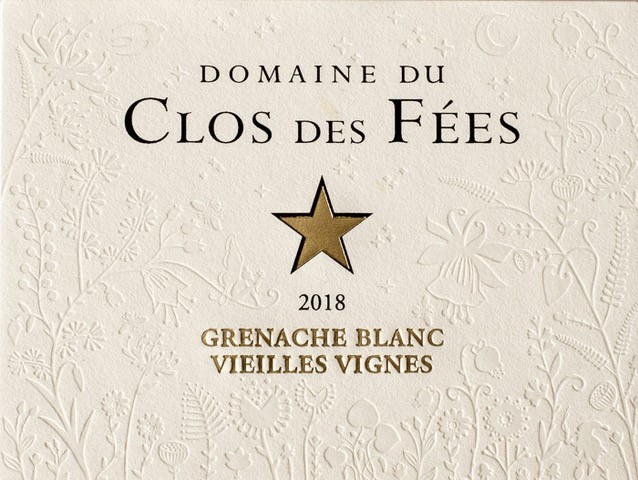

Grenache blanc 90 %, Grenache gris 10 %. Produced with the oldest vines on the estate (over 100 years old) in the area of «Mas Farine». Some old Grenache Gris has been added from mixed plots, planted with various varietals. Limestone-clay soils at an altitude of between 200 and 400 metres, mainly facing North and West.
The date for the harvest is chosen with the aim of obtaining fully ripe fruit flavors while retaining freshness and «drinkability». Hand-picked grapes are transported in a refrigerated truck. The clusters are then pressed fully stemmed at low pressure, in a pneumatic press. Fermentation is carried out slowly in stainless-steel tanks for the Grenache Blanc, and old barrels for the Grenache Gris, with regular stirring. Aging on lees for 5 to 8 months. Fining and filtering prior to bottling in the spring. This rich and powerful wine has an amazing impression of sweetness, even though it is dry. Delicious right when it is bottled, it shuts down for at least 2 years and starts to open up after 3 to 6 years after the harvest.
“Wine always intense, with fruit and flavors, good finish in the palate, with citrus”
2010 Vintage, Guide Bettane-Desseauve 2012 16/20“Nose of dried flowers, fresh almonds, spices. Round palate, with roasted fruit and a fresh finish. Perfect with a fish stew.”
2009 Vintage, Pierre Casamayor, Guide Hubert 2011 4 glasses out of 5 possible“Delicious and tasty. ”
Guide Vin Gault et Millau 2009 16,5/20“An full wine, fat, tasty, full and dense”
Les Meilleurs Vins de France 2008, éditions RVF“Intense flavors, perfect balance between bitterness and acidity”
Millésime 2009, Guide Bettane-Desseauve 2012 17/20“Nose of peach, honeysuckle and anise. Full palate, dense, vibrant and delicious finish.”
Guide Vin Gault et Millau 2008« The 2006 is a taut, strong wine, with floral, verbena and tangerine zest accent. Delicious ».
Jacqueline Friedrich, The Herald Tribune, november 16, 2007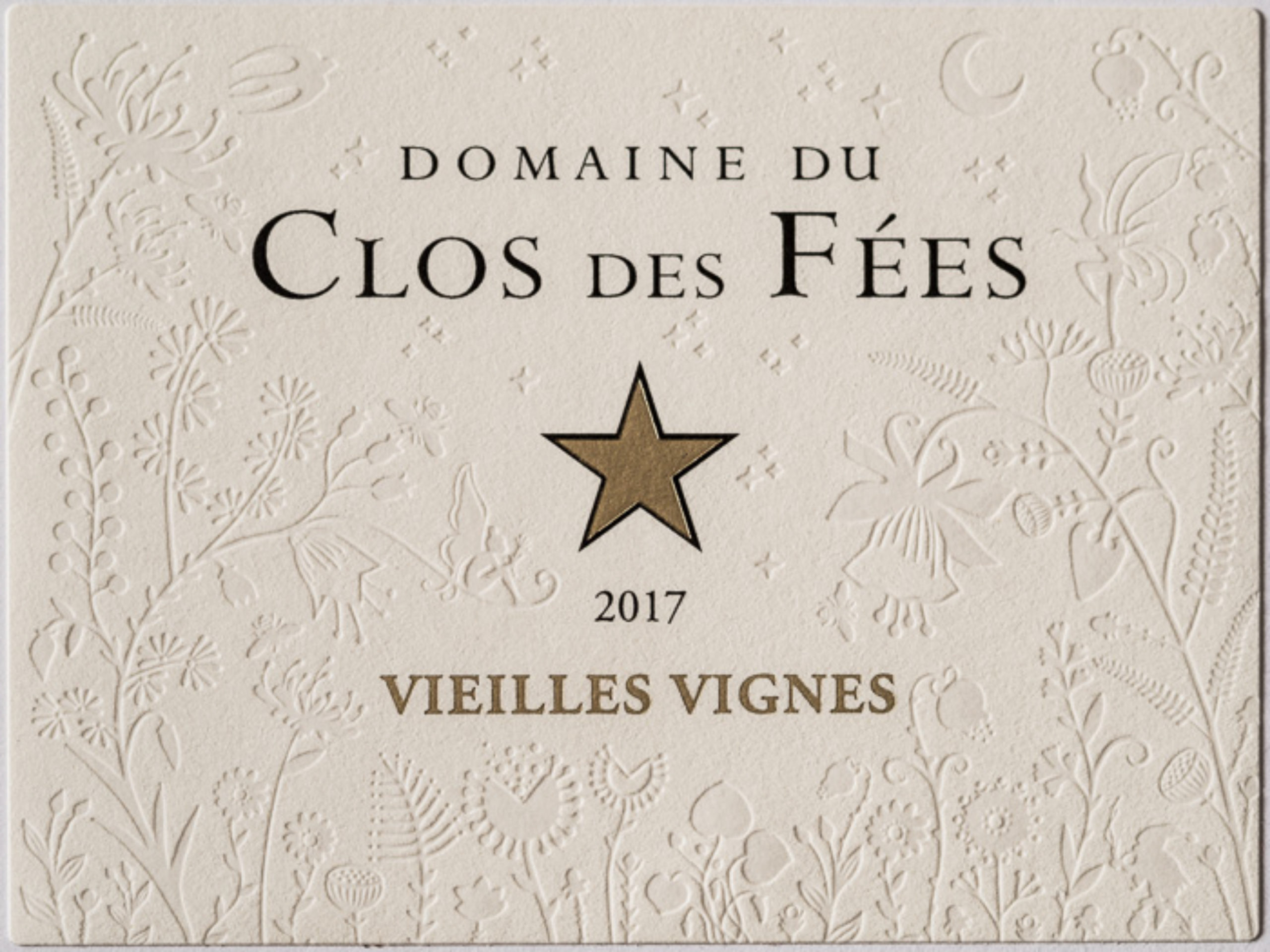

A blend from the oldest vines on the estate (50 to 100 years old): 50 % Grenache et LLadoner Pelut, 35% Carignan, 15% Syrah. Limestone-clay soils, mainly on hillsides, pH >9. Extensive work on the vines: green harvest, bud and side-shoots removal and leaf thinning. Grapes are picked at optimum ripeness, and then sorted in the vineyard and after de-stemming. The harvest is transported in refrigerated trucks. Short pre-fermentary cold maceration in small stainless steel vats, at low temperature with daily punching of the cap and pumping-over. Temperatures controlled in the cap during fermentation. 20 to 25 day macerations with slow and gentle extraction.
Aged without racking for 12 months in one-year and two-year old barrels, as well as traditional cement tanks. Bottled after fining for 2 months in tanks. A naturally powerful wine, with no excess, but extremely aromatic. The silkiness of the tannins makes it enjoyable young, but it will show its full potential after aging in the bottle for at least 3 years. Ideal years cellaring: 5 to 10 year.
« Black fruit jam and blackcurrant liqueur with hints of tobacco and vanilla. Superb concentration. Totally rounded on the palate. Gloriously suave and unctuous texture».
Decanter“Deep black ink robe with garnet reflections. The bouquet is that of an elixir, the epitome of femininity, hints of Licorice come out shamelessly, escorted by cloves, Herbs de Provence and black pepper. It is so thick that it could almost be chewed. The palate is luscious, fleshy, seductive, with chocolate and mint aromas, quickly dismissed by cocoa and raspberry. Infinite finish with mocha and kirsch. Absolutely fatal. until 2029.”
Millésime 2007, Guide des Meilleurs Vins de France 2011 98/100“Intense red fruit aromas, broad volume with tension and freshness, imperative to wait”
Le Monde 17/20“Fleshy, ripe and spicy tannins. Balanced and maturity. Young and lively fruit. Needs time”.
Pierre Casamayor, Revue du Vin de France, février 2008« There's plenty of muscle to the dried raspberry, red currant and smoke flavors. Intense mocha and cream notes fill the spicy finish, along with plenty of dark chocolate. Grenache, Carignan, Lladoner Pelut and Syrah. Drink now through 2015»
Millésime 2006, 92 points Kim Marcus - Wine Spectator, september 10, 2010 92 points“Absolutely fine tannins, spice, licorice, great concentration”
Bettane & Desseauve, Grand Guide des Vins de France 2008“Vieilles Vignes 2005 is supported by a mineral and tannic frame and spicy aromas”
Les Meilleurs Vins de France 2008“Outstanding Achievement in 2005. Superb concentration, elegant aging, superbly spicy”
Revue du Vin de France, Spécial Vin 2007“Floral nose, with a touch of minerals, roasted raspberry, cooled by hints of mint. The palate is very fruity, deep, with fine spicy and cocoa tannins”
2008 Vint, Guide Hubert by Pierre Casamayor 4,5 glasses out of 5« Ripe, seductive, with a deep well of kirsch, cardamom and dark plum flavors. Loads of mocha, cream and spices on the finish »
Wine Spectator, vol 2, n° 12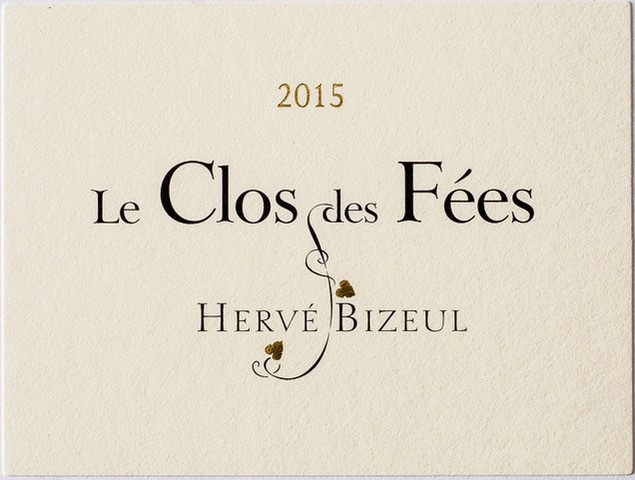

Selected plots of old hillside vines on limestone-clay soil. A blend of equal parts of Syrah, Mourvèdre, Grenache noir, Carignan noir. Intensive work in the vineyards: removal of buds and laterals, bunch equalising, leaf-thinning. Search for optimum phenolic ripeness, adapted for each varietals and each terroir. The havest is brought in and stores in refrigerated truck. Vinification is done in five hectolitre puncheons, de-vatted when warm, malolactic fermentation and ageing in 100% new oak barrels. All operations such as pumping-over, racking and barrel topping are done by hand, without pumps. Aged for 18 months on lees. Unfiltered. Powerful wine, concentrated, rich palate, exceptional creamy texture, yet fresh and focused. Delicious for a year after bottling, if one likes young and powerful wines, but needs to be decanted. Usually shuts-down the second year. Matures slowly and gradually acquires its character while retaining its vibrant fruit. Cellaring potential 8 to 15 years.
“Wine with a precise and tight structure, very fine tannins, freshness and energy”
2008 Vintage, Guide Bettane-Desseauve 2012 17/20“Beautiful floral nose of violets, ripe cassis, oriental spices, hints of rosemary, cashews. Velvety palate, creamy, deep, with exceptional fruit, melted and velvety tannins. To be drunk with a pigeon with spices”
2008 Vintage, Pierre Casamayor, Guide Hubert 2011 5 glasses out of 5 possible“We do not like it but love it... We love this texture expressing the terroir with this chewy structure. It's not consensual, but so true. The nose is a bit reduced, for it expresses aromas of concentrated candied fruit. The Garrigue sings in the glass for the final
Guide Gault et Millau 2011 ✮✮✮✮✮✮✩ 16,5/20« Ultra fine tannins. Phenomenal length. Luxurious wood flavours, very well handled. A class act »
Decanter“The Mourvèdre gives class to this cuvee still in the grip of the barrels, but the material will take over. A must with a powerful and uncompromising style. Will reach its peak in 2010/2018”
Millésime 2007, Bettane & Desseauve, Grand Guide des Vins de France 2011“Woody vanilla, spicy, minty. Fat palate with candied fruits, licorice and pepper. Smooth tannins, powerful, accomplished: Great class
Pierre Casamayor Revue du Vin de France, février 2008« This rich, powerful red delivers intense dark and red fruit flavors that are accented by plenty of zesty, spicy notes. The long finish features snappy red licorice and dark chocolate flavors. Decant before serving. Equal parts Grenache, Mourvèdre, Syrah and Carignan. Best from 2011 through 2015. »
2006 Vintage, Kim Marcus - Wine Spectator, september 10, 2010 93 points“Sleek and elegant wine, muscular, with sleek tannins and classy finish”
Bettane & Desseauve, Grand Guide des Vins de France 2008“This wine stands out for its finesse and balance. The 2005 vintage has succeeded again with its digestibility and freshness”
Les Meilleurs Vins de France 2008“Already a classic wine, which imposes itself, thanks to a generosity and ultra-seductive delicacy”
Les Plus Grands Vins du Monde 2008, Bettane & Desseauve“An impression of brightness, purity, and precision”
Winart

Unique parcel plot (2hectare 32ares 32centiares – 5.74 acres, half productive) of old bush vines of Grenache noir, located on the southern slope of a hillock facing East – West. Planted on a clay-limestone base, layers of shale and mica-schist, dark red in colour and exceptionally rich in iron. Extreme weather conditions: the plot is swept by icy North-West winds more than 200 days per year. Late pruning. Intensive work in the vineyards: buds and lateral shoots removal, bunch equalising, leaf-thinning. Perfect phenolic ripeness is aimed for, while preserving freshness and fruit. Hand-picked grapes are stored and transported in refrigerated trucks. 20 days of maceration with extraction through gentle daily cap-punching. De-vatting in new oak barrels. Aged on lees with no added sulfur until the end of malolactic fermentation. Regular topping-up with a blend of Mourvèdre/Syrah (5 to 7% depending on the vintage). Bottling without filtration. This impressive wine changes depending on the location and when it is tasted. It evolves in the glass over several hours and has an amazingly long finish with strong tannins and a memorable silkiness. Will improve for the next 10 years and can be cellared for 30 years.
“2008 is the most successful year I ever tasted. Great concentration and precision, dense and fresh at the same time, high accuracy. Refined tannins, great balance between fruit and oak. A great wine that will need patience”
2008 Vintage Best wine of the year (20 selected) – 18/20“Petite Siberie is a very fine cuvee totally outside the norm or the category. I recommend you taste this 2009, energetic as a young T-Rex, nourishing as a magic potion. Its price and texture challenge common sense!”
2009, Optimum, octobre 2011“Broad palette of aromas, with hints of violet, candied black fruit, wild mint and peppery cocoa. Very rich mouth, dense and concentrated, but with fresh minerals balancing everything. A perfect pairing with truffles baked in ashes, if you want to indulge”
Vintage 2008, Pierre Casamayor, Guide Hubert 2011 5 glasses out of 5 possible, tenor of the year“This cuvee, made to show what the Roussillon is capable of, needs time for the oak to dissolve, with licorice and black fruits supported by a hint of menthol which justifies its name. Will peak in 2012/2020.”
2007 Vintage, Guide Bettane & Desseauve 2010 17/20“The nose is powerful, with aromas of plum, cassis and caramel. The palate has hints of iodine, with a unique and massive texture which will smooth out quickly”
2007 Vintage, Guide Gault et Millau 2011 ✮✮✮✮✮✮✩ 18,5/20“2006 requires time for the oak to melt, but the quality of the tannins of this wine is outstanding. The freshness of the fruit from this terroir exposed to cold winds is not yet dominant, but the licorice and black fruits on the finish are lovely. Will peak by 2010/2017.”
2006 Vintage, Guide Bettane & Desseauve 2011 16,5/20““This has a rich, frui¬ty aro¬ma, with a ripe, dense cote of dark plum, kirsch and dark cho¬co¬late fla¬vors. Accents of Co¬coa pow¬der, with plenty of light smo¬ke and gin¬ger snap no¬tes, lin¬ger on the broad, spi¬cy fi¬nish. Po¬wer¬ful and ele¬gant Gre¬na¬che. Drink now through 2016.”
2006 Vintage, Wine Spectator 11/2010 - Kim Marcus 94 pts“The quality of the tannins is outstanding. The exceptional freshness of this wine intertwined in spices and licorice comes from the cold winds this cuvee endures. Will peak by 2010/2011.”
2005 Vintage, Guide Bettane-Desseauve 2009 18/20“La petite Sibérie is naturally the opposite of its name. Hyper-rich, packed with flavours, it is a powerful and highly generous concentration of Grenache.”
Thierry Desseauve“Very nice palette of aromas with sleek floral notes. Deep palate, dense, thick with velvety tannins. Great Future.”
Pierre Casamayor, Revue du Vin de France, février 2008“The quality of the tannins is outstanding. Exceptional freshness, with spices, licorice and black fruits in the finish.”
Bettane & Desseauve, Grand Guide des Vins de France 2008 16,5/20“Incredibly complex flavors, silky tannins, endless finish: a cult wine”
Le Figaro Magazine, septembre 2007“Amazing concentration, a big brute dressed in lace, a grandiose wine made from old vines of Grenache”
Optimum« The most expressive wine in the region »
Jacqueline Friedrich, The Herald Tribune, november 16, 2007“Extremely rich concentration, never fall into the traps of over-ripeness and heaviness”
Les Meilleurs Vins de France 2008, éditions RVF“It is today’s Roussillon’s best wine”
Winart“The 2003 cuvee is fragrant with black fruits, spices, cocoa, leather and tobacco; a wine that is both rich and smooth, with exceptionally fine tannins.”
Guide Fleurus des Sommeliers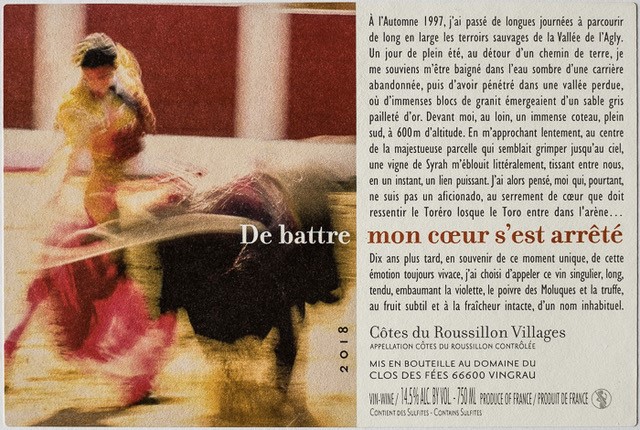

Pure Syrah. Hillside plot located in a complex granitic amphitheater, 600 m (1968.5 ft) above sea level, facing south, southeast, in the town of Lesquerde. Unique terroir, full with minerals (quartz, mica, feldspar). Low pH, looks like poor soil, well drained, yet surprisingly fertile. Easy rooting, allowing good access to water resources. Parcel of approximately 3 hectares (7.41 acres) with thirty years old vines, bush pruning, replanted in 2007 on 2.10 m (6.9 ft) individual poles. Hard pruning. Classic work in green: buds and lateral shoots removal and moderate leaf-thinning. Late parcel. We look for technological ripeness instead of phenolic in order to maintain “fresh fruit” and enrich the aromatic palette. Rapid fermentation with vigorous and frequent pumping-over. Maximum ventilation. Maceration 20 days, keeping the cap submerged. Early malolactic fermentation, moderate addition of SO2 and rapid clarification by successive racking. Aged in vats for five to six months. Bottled in April / May, following light filtration to capture all the energy of an adolescent wine.
“Dense wine, sleek and spicy, without being heavy. Great finesse.”
Guide Bettane-Desseauve 2012 16/20“Natural fruit, with notes of cocoa and spices. Fleshy palate, with plenty of fruit, vivacity and melted tannins. Perfect with lamb chops a la plancha”
2009 Vintage, Pierre Casamayor, Guide Hubert 2011 4 glasses out of 5 possible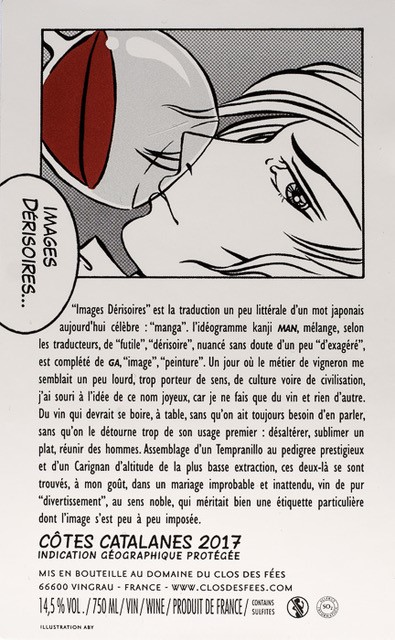

Micro-parcels of 7,000 m2 (1.73 acres) planted in 2005 with Massale selection of Tempranillo, also called “Tinto Fino”. Density of 7,000 stocks per hectare, bush pruning, on individual poles. Carignan planted after the war from parcels located at 450 meters (1476 ft) above sea level, facing west and ripening late. First harvest in 2011. Ripening pushed for the Tempranillo and harvested in early October, by hand and in small crates. Destemmed, pre-fermentation maceration for several days. Carignan are added to bring freshness and power. Traditional vinification with slow fermentation for about two weeks, with light pumping 0ver and soft daily punching down. Aged in vats on lees with frequent open pumping over to avoid reduction. Bottling after light filtration and minimum SO2. Black and dense wine. Compact and dense palate, both velvety and … rustic. Unusual wine, disconcerting but with a tasty finish, leaving a fresh and engaging palate. Unique wine with character.
“Hervé Bizeul was the first to seek the very substance of the terroir which is expressed in this wine with strength and vigor”
Gault et Millau, Hors Série, printemps 2012“This bottle, born in a garage, will wreak havoc”
Objectif LR – Novembre 2011Majority of Cabernet-Franc from high quality Massale selection. Planted 6,800 vines per hectare, bush pruning, on individual poles. Parcel facing north on the western side of a limestone cliff. Vines were planted so each stock protects its neighbor from direct sunlight. Merlot located in an area called “Le Clos des Fees”, bush pruning, crowded multi-clonal planting on poles. Harvest done at the end of phenolic maturity. “Mixed bays” vinification done in controlled temperature, with punching down and open pumping over. Barrel aging, partly new, and then in tank until bottling, done early, usually in May/June Objective being finesse, length and salinity for a new expression of this varietal grown on a very fine terroir of clay and limestone. Dark garnet wine, ripe red fruit nose and delicate hints of oven roasted red peppers. Tannic palate, silky, long, distinguished, the term “classic” comes immediately to mind. The label changes every year, the Faune slowly growing up with the wine…
100% Sémillon. 50 acres plot, a 15 year-old grape grafted in 2006 with massal selections of Sémillon from the Meditrranean region using the cleft grafting method.
Vine in cord of Royat.
Work on the perfect ripeness of the grape. Hand-picked grapes at dawn then transported in crates. Carried to the cellar in refrigerated trucks. Long pneumatic pressing (5 hours), whole grapes. Cold debourbage. Put in new 500 litres demi-muids. Long fermentation (6 weeks) with natural yeasts. Aged in the same containers with monthly stirring. Matured on lees for 12 months. Malolactic fermentation. Rested in tanks for 6 months, then light filtration before being bottled. Minimal SO2. Aged in bottles for a minimum of 24 months at the Domain.
Liquid gold colour, complex nose, surprising notes of beeswax, saffron, homemade apricot jam and Bourbon vanilla. Ample and powerful mouth with obvious tannins and a neverending finish with a touch of well-controlled oxidation. After airing for one hour, its bouquet turns into rose and peony. Surprisingly fresh despite the richness and strength of a white wine “à l’ancienne”.














